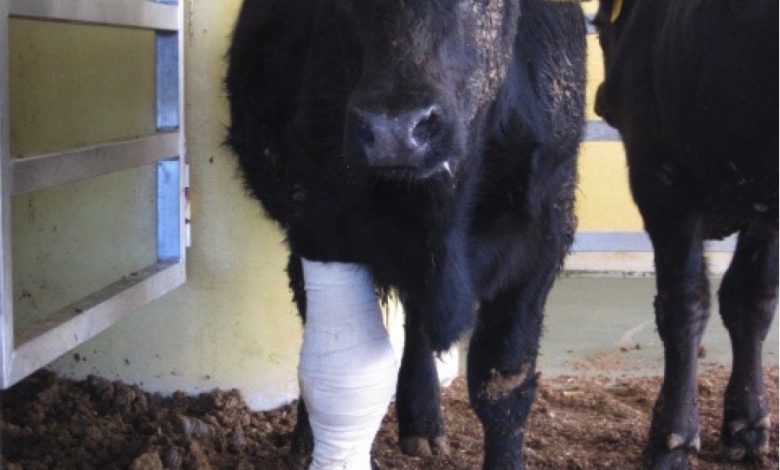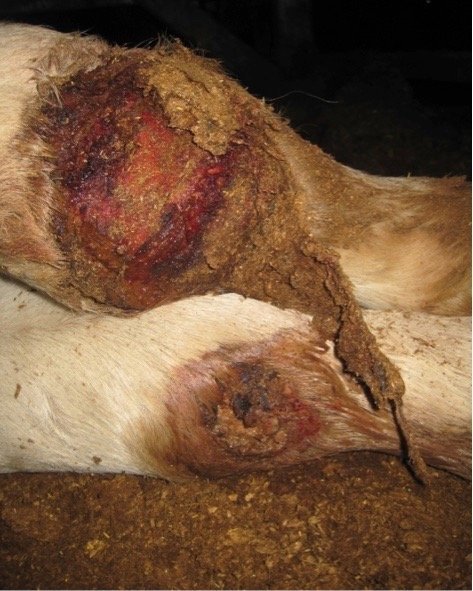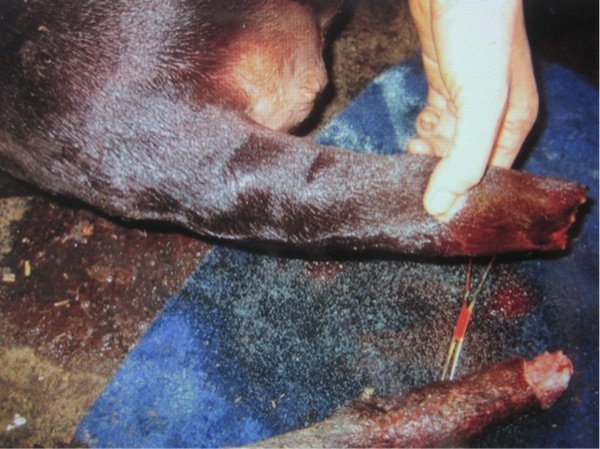Live Animal Export: Injuries onboard

I should never have put a single bandage on. I should have shot them all in the head. It would have been the more humane thing to do – Dr Lynn Simpson’s fearsome eighth contribution on the livestock trades.
To avoid injuries to cattle and sheep in the live export trade there are three major options. Redesign the animals, modify shipping standards or stop putting live animals into unnatural environments.
Cattle have survived well for centuries on land, however once we expose them to the traps and risks of man made transportation they often suffer.
Trucking has its risks, as does the frantic pace of getting a shipload of anything ready for a tightly timed and choreographed, expensive logistical timetable.
Live export ships however are the equivalent of dynamic, multistory car parks with railings. Oil and water. Even the deck crew can tell you the two shouldn’t mix. This environment is dangerous to humans and animal alike; many hazards exist.
Serious injuries commonly seen are cuts, fractured bones, chronic abrasions, internal injuries from being thrown against rails in bad weather and misadventure.

Misadventure is usually the most interesting, but only for the bystander. The animals involved can suffocate in their own feed troughs, get their body parts stuck in unnatural traps, submersible bilge pump cavities, air supply vents, through narrow railings, and gaps in infrastructure that livestock misjudge as passable. On occasion I’ve had to shoot and help crew dismember perfectly healthy animals to enable extracting them from entrapment. This is frustrating, tragic and poor for crew morale.
What can we do? The animals haven’t read the memo.
There is an upside to these tragedies.
Seafarers are too often fed poorly and on a very tight budget. Usually ‘Cookie’ does the best he can, the meals are often supplemented with extra oil and carbs to meet energy requirements to meet the crew’s requirements. Most of the crews I worked with are on deck from 06:00 to 18:00 (with requisite breaks), seven days a week for the full duration of their 10-month contract. Their fatigue is usually visible and you can pick the guys near the end of their contracts by the rib count or their demeanor.
As such, seafarers often crave red meat and ironically the product in walking form overwhelmingly surrounds us. Whenever I had a beast with a clean injury such as a broken leg that required euthanasia for humane reasons I would usually check with the crew before killing it. I would ask if they were interested in increasing their beef intake. The answer was usually in the positive. So without further delay I would carefully sneak up on the poor beast and shoot it dead and let the crew do the butchering to their liking. If I had no option or the animal was in anyway ill or had had any medication for any reason, I would heavily sedate the beast and shoot it once it was unconscious. The body would then be thrown to the sea.
Feeding the crew made the animals loss of life a lesser waste but I never let my crew consume any meat contaminated with medication. Its hard enough looking after up to 20,000 cattle and nearly 100 crew, the last thing I needed was to cause any anaphylactic reactions or ill health from contaminated or unhealthy meat consumption.
I spent much of my decade as a seafarer monitoring, isolating, sedating, treating and healing animals with injuries. Some were weird, like the bull that kept chewing through all his mate’s tails and I had to amputate the leftovers.

Most injuries were leg related. Cuts and abrasions that got infected in the ever-present deep shit on the decks. They required relocation to a hospital pen, sedation, cleaning and protective bandaging to reduce further abrasion and to keep the wounds clean of shit.
Some animals were treated so often for multiple injuries that they became quite docile and the treatments could be done without chemical restraint.
Other cattle wanted to kill you no matter how nice you were to them and required sedation, and a handful of crew to hold them still for treatment. These animals challenged both the crews safety and their own. They were often quite pissed off about their situation and I don’t blame them one bit.
On the eve of leaving my last voyage in mid-2011, I sat in a hotel room in Moscow. Wine in one hand, and a clenched fist in the other and watched with absolute disgust an exposé online. It was just released on Australian TV, nights before. The live export trade was shaking in their collective boots.
My phone had gone nuts about it as soon as I got phone range from the Black Sea. The exposé, A Bloody Business showed video footage of how live exported animals from Australia were routinely being slaughtered in abattoirs in Indonesia. I’ve never delivered animals to Indonesia, but it was soon discovered that many of the countries I was delivering into had similar barbaric and cruel slaughter procedures.
This was an earthshattering revelation at its best, or worst as the case may be. It showed disgusting, unnecessary, cruelty towards animals that deserved better. It proved there were cover-ups in the trade’s management and agenda. It meant so many people associated with live export including me were inadvertently, and unknowingly complicit to atrocities. It tarnished all the good work of many, including the seafaring crews who worked so hard on our ships to provide for the animals in out care.
The crew and I had risked our safety and lives to feed, treat and heal these animals only to unknowingly often deliver them to a demise of torture and a cruel death.
I should never have put a single bandage on. I should have shot them all in the head. It would have been the more humane thing to do.
For Lynn’s full archive of shocking exposés into the livestock trades, click here.

This woman is my hero and how she was treated is a crime. What was done to her shows that too many in charge show no humanity at all. In time things will change as more and more like her move into positions of influence. Why anyone wants this country to get a name similar to third world countries or those who do not believe in any type of human or animal rights is beyond me, and many like me. I hope she finds employment in one of the organisations who is fighting cruelty in all its forms. We have so little people in this world who have her skills and still retain their compassion.
I commend this magazine for giving her a voice.